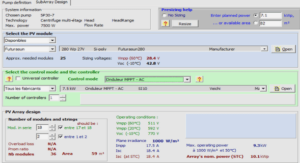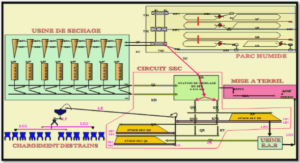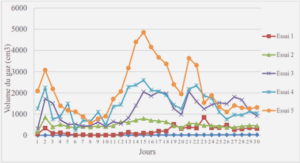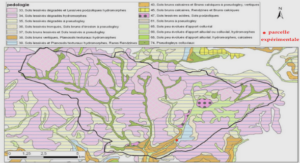Influence évolutive du feu
Impacts of postfire logging on burn-associated beetles in boreal forest: temporal dynamics
There are a few evidences that salvage logging could hamper natural ecological recovery processes, such as the regeneration of plant species. Indeed, if some boreal saproxylic species are adapted to postfire habitat with which they have evolved, salvage logging might exceed their resilience. This study aimed to identify burn-associated species of the northern boreal forest of the province of Quebec in Canada, and to determine the effect of reducing the merchantable tree basal area through time following salvage logging after fire, on the assemblages of these burn-associated species. Salvage logging was conducted from August 2005 to May 2006 after wildfires that prevailed in 2005, in the Chibougamau region. We sampled beetles over three years after salvage logging (2006 – 2008) using multidirectional flight-interception traps. Ten traps were installed in ten plots equally distributed between unburned black spruce (Picea mariana Mill. B.S.P.) and jack pine (Pinus banksiana Lamb.) dominated stands, where 11 mature trees (dbh > 9 cm) were girdled in order to generate recent snags. Thirty-six other traps were set in 36 plots distributed between burned black spruce and jack pine dominated stands residual from salvage logging in order to cover the largest gradient of salvage logging levels. For each burned plot, we measured habitat attributes affected by salvage logging which could influence burn-associated assemblages’ structure, such as the basal area of residual trees by species and diameter classes at different scales (0.04 ha and 7 ha). We also measured the distance from the sites to the unburned continuous forest and fire severity, using the delta Normalized Burn Ratio (dNBR). By studying beetle assemblages from selected families (Buprestidae, Cerambycidae, Cleridae, Corylophidae, Curculionidae, Elateridae, Lathridiidae and Salpingidae) found in burned and unburned plots with girdled trees, we identified 18 burn-associated species. These burn-associated beetles only responded to salvage logging starting from year no.2 (2007) after salvage logging. Burn-associated beetle assemblages were mainly shaped by three groups of environmental factors: 1) prefire forest conditions such as tree species composition; 2) conditions generated by fire event such as the distance to the unburned forest, which is directly affected by the shape of the burned area, as well as burn severity; 3) the amount of salvage logged area and the associated reduction of the amount of mature size coniferous snags (dbh > 9 cm). Keywords: Boreal forest; Fire ecology; Burn-associated species; Coleoptera; Salvage logging; Burn severity; Snags.
Introduction
Geological records of fossil charcoal, a proxy of fire, indicate that wildfires rapidly followed the appearance of terrestrial plants; this suggest that fire have had strong evolutionary impacts on biota along the history of terrestrial life (Glasspool et al., 2004; Scott and Glasspool, 2006; Bowman et al., 2009). This natural disturbance influences global ecosystem patterns and processes; these include vegetation distribution and structure, biomass production, geochemical cycles, climate and biodiversity (Weber and Flannigan, 1997; McCullough et al., 1998; Bourgeau-Chavez et al., 2002; Bowman et al., 2009). Wildfires do not only remove species and simplify vegetative structure; it also generates new habitat features, from micro-habitat to the landscape scale, which are referred as pyrogenic structures (Kennedy and Fontaine, 2009). These habitats are mainly characterized by open stands with warm and exposed mineral soils, by high abundances of fungi and as time goes, by an increasing shrub cover (Wikars, 1992; Nappi et al., 2004). At the landscape scale, wildfires represent the main cause for generating dead wood in boreal forests (Siitonen, 2001; Drapeau et al., 2002; Nappi et al., 2004; Kennedy and Fontaine, 2009). Fire-killed trees are habitats for a large diversity of invertebrate saproxylic species (Wikars, 1992; Saint-Germain et al., 2004a; Boulanger and Sirois, 2007), which are important in wood decomposition (Speight, 1989; Kim, 1993; Boulanger and Sirois, 2007), and a non-negligible part of many vertebrate species diet (Morissette et al., 2002; Purdon et al., 2002; Nappi et al., 2004; Kennedy and Fontaine, 2009). Invertebrate saproxylic species are defined as species that depend, during a part of their life cycle, upon wood of moribund or dead trees (standing or fallen), or upon wood-inhabiting fungi, or upon the presence of other saproxylics (Speight, 1989). Amongst boreal forest’s saproxylics organisms, beetles (Coleoptera) are the best known and the most diversified taxonomic group, both in terms of taxonomy and ecology (Niemela, 1997; Siitonen, 2001). Moreover, saproxylic beetles are the most vulnerable group of Coleoptera to extinction in boreal forests of Fennoscandia because of the reduction in the availability of dead wood (Hyvàrinen et al., 2006) which is mostly due to intensive forest management (Siitonen, 2001) and extensive fire suppression (Wikars, 1992). Saproxylic organisms that are conspicuously favoured by fires are defined as pyrophilous (Wikars, 1997b). However, the term pyrophilous raises some controversy (see Nappi et al., 2004) and we prefer to use burn-associated species, to define species that are strongly associated (i.e. found in high abundance/incidence) with postfire habitats. Burn-associated species are expected to use snags produced by wildfire to increase their population level, which is hypothesized to allow their persistence in suboptimal unburned habitats until the next regional wildfire (Wikars, 2002; Nappi et al., 2004). Such species would thus be more likely to be negatively affected by a reduction in the availability of postfire habitats than opportunistic saproxylic species, which are fund in burns with high abundance because of the massive snag recruitment, but are more associated to other sources of recently killed trees.
Even if it is still common in the Canadian boreal forest landscape, the regional importance of recent burns habitats is expected to decrease in the near future due to climate-related decrease in fire frequency, especially in western Quebec (Bergeron et al., 2001; Flannigan et al., 2001). Moreover, increasing pressure by salvage logging may have a stronger impact on the reduction of postfire habitat availability, as the development of extensive road networks is rapidly increasing, making burns more accessible (Nappi et al., 2004; Schmiegelow et al., 2006). In addition, the technology for treating fire-killed wood in lumber mills continues to improve (Saint-Germain and Greene, 2009). In fact, widespread trend in the intensification of postfire logging in boreal forest has been observed, which raised some concerns about conservation issues (Dellasala et al., 2006; Lindenmayer et al., 2008). Indeed, if boreal saproxylic species are presumably well adapted to fire recurrence with which they have evolved (McPeek and Holt, 1992), it is important to make sure that salvage logging following fire does not exceed their resilience (Le Goff et al., 2008). There is yet abundant theoretical and empirical evidence that salvage logging interferes with natural ecological recovery (Lindenmayer and Ough, 2006) and has several negative impacts at the extent of salvage
activities, on both vegetation and wildlife (Nappi et al., 2004) at the extent of salvage activities. Amongst these impacts, one of the most important is the removal of foraging and nesting habitats for wildlife (e.g. snags), that harbour large numbers of insect larvae, thus reducing the availability of prey for insectivorous birds (Morissette et al., 2002; Purdon et al., 2002). It has also been reported that salvage logging reduces the average persistence of leftover snags, which are more vulnerable to windthrow when forest openings become abundant across the landscape, and it obviously reduces average diameters of lingering snags and stand densities (Russell et al., 2006). Moreover, the removal of merchantable snags reduces in situ seed sources that are important for establishing tree regeneration; full sun exposition also results in higher variations in soil temperatures (Greene et al., 2006) leading to desiccation and to a reduction in suitable seedbed and growth conditions for understory plants and trees (Purdon et al., 2002). This tends to homogenize and to reduce the cover and diversity of plant communities (Purdon et al., 2002). Furthermore, patterns of within-stand structural complexity are altered as snags and residual living trees are removed (Lindenmayer et al, 2008); within these simplified stands, the assemblages of plants and animals are modified as functional groups decline or are lost (Lindenmayer and Ough, 2006).
To evaluate the impact of postfire salvage logging on bum-associated species, we specifically looked at eight beetle families (Buprestidae, Cerambycidae, Cleridae, Corylophidae, Curculionidae, Elateridae, Lathridiidae and Salpingidae) known to contain many saproxylic species and/or having many species that mostly occur in bums (Wikars, 1992; Wikars, 1997a; Siitonen, 2001; Saint-Germain et al., 2004a; Boulanger and Sirois, 2007; Moretti et al., 2010). Few studies have directly evaluated the response of boreal forest communities to salvage logging, most have considered bird
communities (Morissette et al., 2002; Cahall and Hayes, 2009; Azeria et al., in revision) and one considered bryophyte communities (Bradbury, 2006). The response of epigeic carabid beetles to postfire salvage logging has been studied, and indicated that communities differ between burned forest and salvage logged forest (Phillips et al., 2006). The same study also outlined that carabid’s response towards salvage logging was different from the one to harvesting in unbumed forest, suggesting that postfire forest management requires particular considerations (Phillips et al., 2006). Although to our knowledge, our study is the first to address this issue by studying the response of
saproxylic beetles5 assemblages over time to postfire salvage logging.
|
Table des matières
Table des matières
RÉSUMÉ
ABSTRACT
AVANT-PROPOS
REMERCIEMENTS
TABLE DES MATIÈRES
LISTE DES TABLEAUX
LISTE DES FIGURES
LISTE DES ANNEXES
1. INTRODUCTION GÉNÉRALE
L1 Influence évolutive du feu
1.2 Importance des brûlis pour les coléoptères saproxyliques
1.3 Problématique
1.3.1 Impacts de la récupération après feu
1.3.2 Lois protégeant la biodiversité
L4 Contexte de Vétude
IMPACTS OF POSTFIRE LOGGING ON BURN-ASSOCIATED BEETLES IN
BOREAL FOREST: TEMPORAL DYNAMICS
ABSTRACT
1. INTRODUCTION
2. METHODS
2.1. Study area and sampling plots
2.3. Habitat attributes
2.3.1. At the 0.04 ha scale
2.3.2. At the 7 ha scale
2.4. Statistical analysis
2.4.1. Abundance and species richness in burned versus girdled plots
2.4.2. Species assemblages in burned versus girdled plots
2.4.3. Burn-associated species
2.4.4. Burn-associated species models relating abundance, species richness and species turnover to habitat attributes
2.4.5. Burn-associated beetle assemblages and habitat relationship
3. RESULTS
3.1. Abundance and species richness of burned versus girdled plots
3.2. Beetle assemblages in burned versus girdled plots
3.3. Species associated with burned versus girdled plots
3.4. Models relating abundance, species richness, species turnover and assemblages of burn-associated species to habitat attributes
3.4.2. Trees of non-merchantable dimensions (JPLY, BSP.Y, and Y.Stands)
3.4.3. Down dead wood (JPI.DDWandBSP.DDW)
3.4.4. Burn severity (Brn.Sev) and distance to green forest (Dis.GF)
3.4.5. Salvage area (Sal.Area)
4. DISCUSSION
4.1. Burned versus girdled plots
4.2. Burn-associated species
4.3. Salvage logging, habitat attributes and burn-associated species: temporal dynamics
4.3.1. Importance of prefireforest condition
4.3.2. Importance of fire severity and distance to unburnedforest
4.3.3. Temporal effect of postfire salvage logging
4.4. Conclusion and management implications
ACKNOWLEDGMENTS
REFERENCES
TABLES
FIGURES
APPENDIX
2. CONCLUSION GÉNÉRALE
2.1 Diversité entomologique associée aux brûlis
2.2 Effet temporel de la coupe de récupération et des attributs de l’habitat sur les espèces associées aux brûlis
2.3 Implications pour l’aménagement des brûlis et perspectives d’avenir
RÉFÉRENCES
![]() Télécharger le rapport complet
Télécharger le rapport complet





